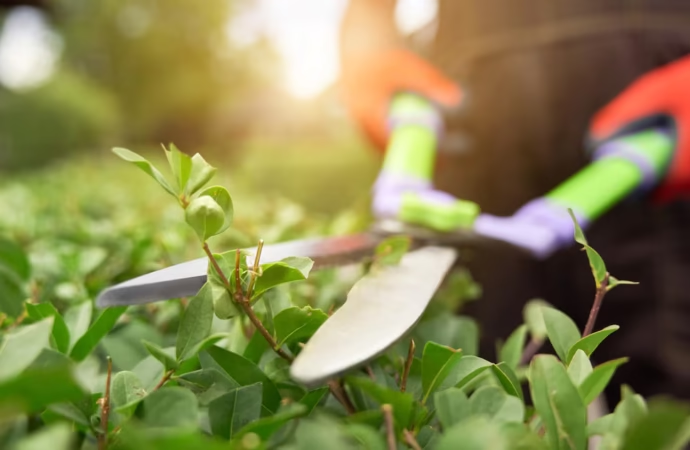A shaded part of your lawn should be perfect for relaxing on hot summer days, but it can be a difficult place to grow plants. However, you can grow pretty plants in a shady spot if you pick the right seeds and take care of them properly. Luckily, there are some tips on how to
A shaded part of your lawn should be perfect for relaxing on hot summer days, but it can be a difficult place to grow plants. However, you can grow pretty plants in a shady spot if you pick the right seeds and take care of them properly.
Luckily, there are some tips on how to feed and seed your lawn under a shade, and we have brought you a post to help them thrive. So, perform the following tasks if you need to make your lawn lush and leafy and bring new vegetation to the surface.
Use Moss Killers In Spring And Fall
One of the most common problems in shadow gardens is moss. It usually grows in moist and cold places, especially in the months of fall and winter.
You can use ferric sulphate to prevent moss from taking over your garden. It’s a soluble compound mixed with water before spraying on the lawn. You can use a sprinkler or knapsack sprayer to spray evenly in each lawn area.
To ensure the safety and effectiveness of the product in your shadow garden, measure the amount carefully and follow the instructions on the product label because overapplication of ferric sulphate can be harmful to plants.
As moss is most active in fall and winter, this is the best time to apply ferric sulphate. Applying it at other times, such as during the summer when the weather is hot and dry, can stress your lawn and other plants.
Regular Maintenance And Special Shade-Tolerant Plants
Choosing the correct seeds for a shaded garden is the most important part of creating and maintaining a healthy garden. For this, you can choose shade-tolerant plants that can thrive in low light conditions, which is usually a mix of tough fescue and thin and chewy fescue.
Sprinkle On The Ground For Your Shadow Garden
Landscaping can be a big project, but having the right tools can make it easier and more efficient. Some common tools that can be useful for landscaping include Shoes, vacuum cleaners and light forks. Having these tools can make your landscaping tasks easier and ensure that the work is done more efficiently and effectively.
Before starting any landscaping project, it’s important to assess your needs and choose the best tools suited for the job. Even if you can’t do all the weeding at once, you should try to make sure that the area is limited to where the weed is most common.
Add A 70/30 Sand/Soil Mixture
Adding a 70/30 sand/soil mixture to your shadow garden can greatly improve drainage and promote healthy plant growth. The soil itself will help with seed-soil contact when the seeds are growing.
Many expert gardeners suggest that it’s best to sow the seeds first. And then, spread the sand/soil mixture evenly over the area you want to plant because the soil on the top will protect the seeds from birds and help small plants to penetrate the soil. With this tip, you can create a healthy and vibrant shadow garden that will be the envy of your neighborhood.
Use Lawn Sand With Added Nitrogen And Iron
To improve the health of your shadow garden, it can be beneficial to use lawn sand with added nitrogen and iron.
Before applying lawn sand with added nitrogen and iron, make sure your grass is established and has been growing for at least a few weeks. This will help ensure that the grass can benefit from the added nutrients in the compost.
The best time to apply lawn sand with added nitrogen and iron is during the growing season, which typically runs from March to September or October. Apply the compost 2-3 times during this period to provide a consistent source of nutrients for the grass.
Additionally, If you use a moss remover product, do not mix it with the lawn sand with added nitrogen and iron. Apply these products separately and according to their instructions.
Feed At Regular Intervals
Every plant needs regular feeding to survive. However, grasses require different levels of nutrients at different times of the year. For instance: In spring and summer, it needs more nitrogen, and in fall and winter, it needs more potassium.
All fertilizers have a value called N-P-K. Shows the amount of nitrogen, phosphate and potassium they contain.
In the fall and winter, you should use a feed with a higher potassium content, such as 12-6-18 or 8-10-12. Potassium helps the grass to build stronger roots, making it more resistant to cold weather and disease. And in the spring and summer, you should use a feed with an NPK of about 18-5-10, which means a lot of nitrogen.
When applying fertilizer, it’s important to follow the instructions carefully and avoid over-fertilizing, which can damage the grass and pollute nearby waterways. Always water the lawn well after applying fertilizer to help it absorb the nutrients.
Shave Once A Year
Mowing the lawn regularly is also important for maintaining a healthy lawn. In shaded areas, it’s important not to cut the grass too short, as longer blades can help capture more sunlight for photosynthesis. It’s recommended that you mow at most one-third of the blade length per cut.
If you have a large lawn, investing in a mulching mower is a good idea, which can help return nutrients to the soil as it mows. Otherwise, consider composting the grass clippings or using them as a natural mulch around garden beds.

















Leave a Comment
Your email address will not be published. Required fields are marked with *